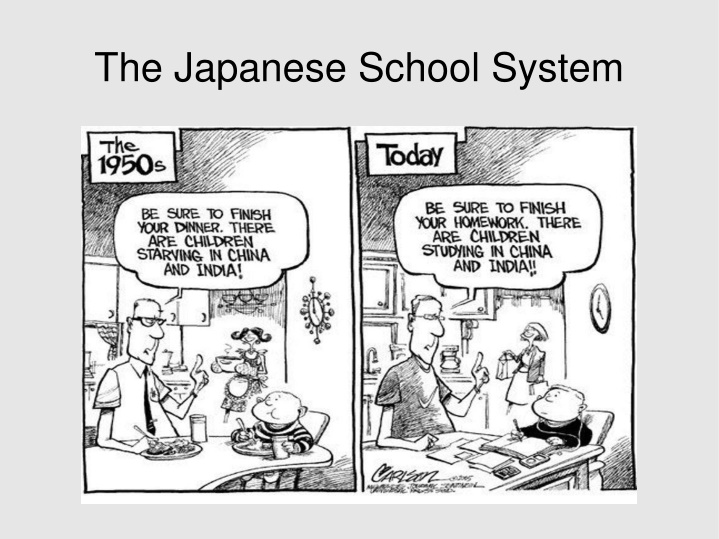Insights into the Japanese School System
Explore the structure and statistics of the Japanese school system, including an overview of educational hierarchy, teacher demographics, student schedules, and English language requirements. Learn about school statistics, class sizes, teacher employment conditions, and student activities. Discover interesting facts about teaching conditions and the educational landscape in Japan.
Download Presentation

Please find below an Image/Link to download the presentation.
The content on the website is provided AS IS for your information and personal use only. It may not be sold, licensed, or shared on other websites without obtaining consent from the author.If you encounter any issues during the download, it is possible that the publisher has removed the file from their server.
You are allowed to download the files provided on this website for personal or commercial use, subject to the condition that they are used lawfully. All files are the property of their respective owners.
The content on the website is provided AS IS for your information and personal use only. It may not be sold, licensed, or shared on other websites without obtaining consent from the author.
E N D
Presentation Transcript
Overview The Japanese Educational Sysytem The School Hierachy Teachers Pupils and Students English in Japan The Classroom and Team Teaching Why We're Here
School Statistics There are a total of 56,657 schools in Japan ~21,000 ES -> 5,000 HS 95% are public schools. >99% are co-ed.
School Statistics Class sizes are significantly larger than other countries.
The School Hierachy Kocho Sensei Fukukocho / Kyoto Sensei Kyoumubucho Bucho / Shunin Jimubucho Sensei Tantosha Jimushokuin You
Meet Your Teachers 1,338,854 teachers in Japan. 111,111 (11%) in KG 417,553 (41%) in ES 254,235 (25%) in JHS 235,062 (23%) in HS Overall ~50% female Heavyly scewed at different levels
Meet Your Teachers Most teachers are prefectural employees. Teachers are generally employed for life. - Promotion is based on seniority. - Dismissal is rare, and normally only for unethical conduct. Teachers change schools every few years. ~90% have completed a 4 year degree course. - The majority in a field other than education.
Teaching Conditions Source:2006 Report on the Survey on the Actual Conditions for Teachers (Elementary and Junior High Schools), MEXT.
Meet Your Students At least 210, typically 240 to 250 days a year. A full month more than American students! 30 hours of Lessons per week. ~60% attend cram schools. Almost all are club members. >96% continue to high school.
English at School English is compulsory from grade 5 (age 10) onwards. From JHS English takes 140 class hours per year. ~400 new words a year + Various idioms and grammatical forms. Based on the communicative approach.
An English Lesson Typically 50 minutes long. Mainly textbook based. Read ahead and plan activities around it. Role of the ALT: Provide insight and useful expressions Interact with and motivate students Give them confidence ALT should (ideally) speak only English. ALT only present for a few of the lessons.
Studying English In class instruction includes: Memorizing vocabulary Practicing basic sentences and grammar Simple translations At it s most basic: Brief passages are read and translated. Students practice writing short compositions.
English and YOU Where do you fit into all this? ALTs always work together with a JTE (Japanese Teacher of English) to plan and teach classes. Your job is to assist JTEs by providing input, insight and interesting activities. Show your students natural English and let them negotiate meaning.
Why is English Important? World s universal language. Set to become even more ubiquitous in the future. Selection criteria for high school and university. Make links with other nations. Requirement for many jobs. Lawyers, Doctors, Politicians
Team Teaching Don t just use your partner as a tape recorder / translator. Good teaching practice is for both of you to work together.
What is team teaching? Team teaching involves a group of instructors working purposefully, regularly, and cooperatively. Together they set goals, design a syllabus, prepare lesson plans, teach, and evaluate results. They share insights, experience, and perhaps even argue to decide which approach is best.
Benefits of Team Teaching Research shows team teaching is best. Methods and results can be evaluated. Future classes get better. Newer teachers can be critiqued. Help other teachers in the future. Teacher strengths are combined and weaknesses remedied. Eliminates personality clashes. More time for each student.
A Brief History of ALTs In the mid 80 s countries were ranked by their scores on the TOEFL (Test Of English as a Foreign Language). Of the 189 UN countries that took part, Japan ranked in at number: 180
J.E.T.-nesis (sorry!) The JET program was born in 1987 as a response to this. An attempt to bring western style language learning to Japan (communicative approach). ALTs offer: Native language experts A chance to practice non-textbook English Motivation and rewards for good students
The JET Effect TOEFL scores have improved Japan has surpassed about 50 countries, bringing them close to the international average. Everyone in Japan under 40 has had a positive experience with foreigners and second languages. More and more Japanese students are studying at foreign universities, despite rising costs. Government poll found high degrees of satisfaction from schools taking part in the JET Programme. Now, it s your turn!
Why We Are Here We are here to: Assist with teaching to the best of our abilities. Introduce students to our native languages and cultures. Acclimate students to interacting with foreigners. Illustrate, however abstractly, that second languages are real and maybe even useful. Be an ambassador for your country.






















